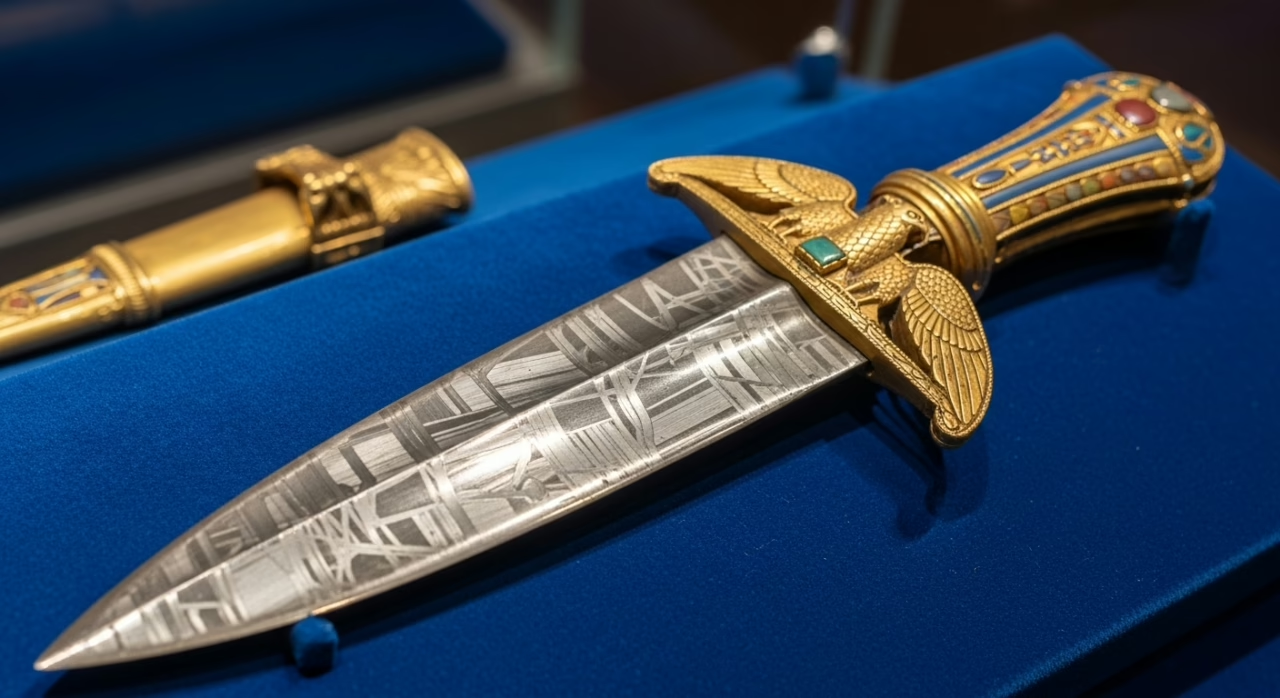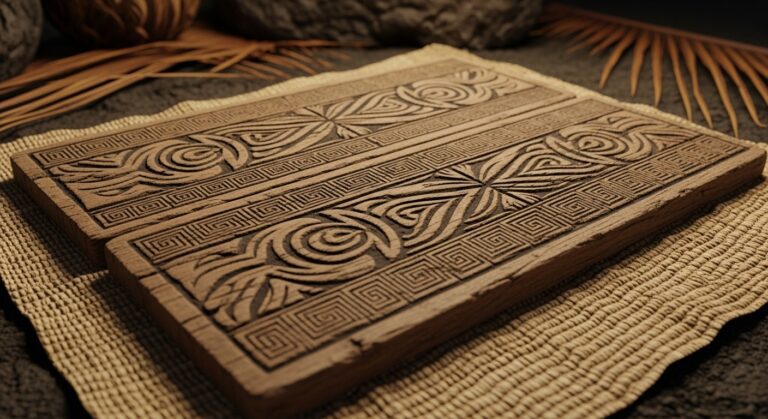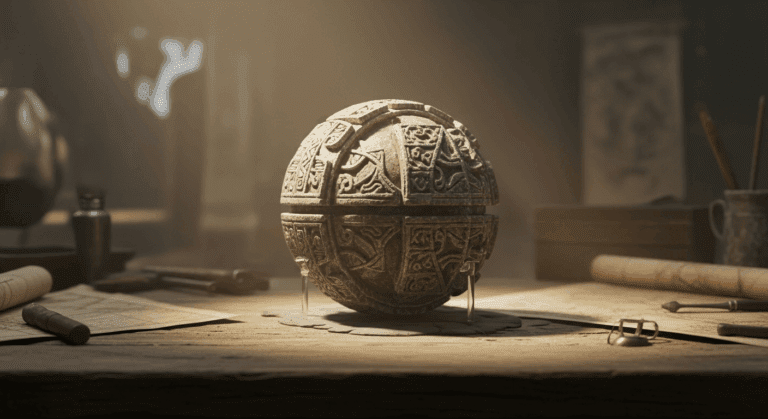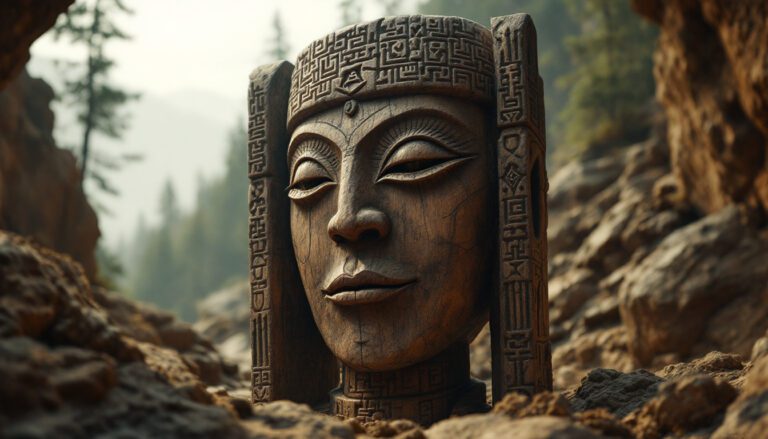King Tut’s Meteorite Dagger: Meteorite Metal in an Ancient Pharaoh’s Tomb
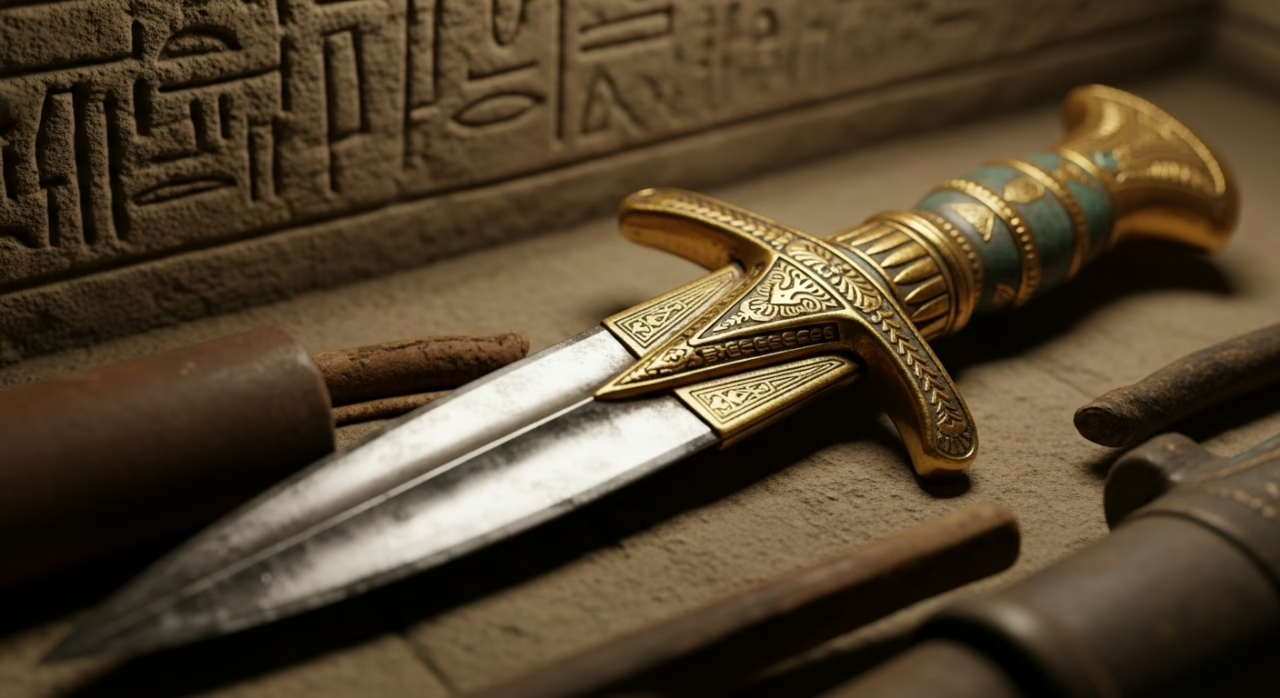
A Blade from the Stars: Tutankhamun’s Meteorite Dagger – Among the treasures unearthed from Tutankhamun’s tomb, one artifact transcends mere opulence to connect ancient Egypt with the cosmos itself: a dagger forged from meteorite iron.
This celestial metal, fallen from the heavens and transformed by skilled hands into a royal implement, represents a fascinating intersection of astronomy, metallurgy, and royal prestige.
The blade’s otherworldly composition raises compelling questions about how ancient Egyptians identified, valued, and manipulated this rare material, centuries before iron metallurgy became commonplace.
Key Takeaways
Hide- King Tutankhamun's iron dagger, discovered in 1922, was made from meteorite material confirmed through chemical analysis.
- The dagger contains 11% nickel and significant cobalt concentrations, signature elements that prove its extraterrestrial origin.
- Found strapped to Tutankhamun's mummy, the dagger features a gold handle with precious stone inlays and crystal pommel.
- Ancient Egyptians considered meteoritic iron sacred, elevating the dagger's significance as a divine connection for the pharaoh.
- The artifact's preservation and craftsmanship demonstrate sophisticated metallurgical techniques previously thought impossible in Bronze Age Egypt.
Discovery and Preservation of the Tutankhamun’s Dagger
Howard Carter’s 1922 discovery of Tutankhamun’s tomb revealed a wealth of treasures, including an ornate dagger found still strapped to the mummy’s thigh, its blade gleaming with an otherworldly luster despite its 3,200-year entombment.
The iron dagger, housed in a gold sheath adorned with feather patterns, remained remarkably preserved in the dry conditions of the Valley of the Kings, with minimal corrosion that puzzled early archaeologists given the ancient date of its forging.
Its exceptional state of preservation allowed scientists decades later to conduct definitive analyses confirming its extraterrestrial origin, the blade’s cosmic composition having weathered the millennia far better than would terrestrial iron of the same period.
The dagger’s craftsmanship mirrors the intricate funerary items found in Etruscan tombs, which similarly provide insights into ancient values and beliefs surrounding metalwork and prestigious artifacts.
Unearthing the Blade in the Valley of the Kings
Howard Carter’s meticulous excavation of Tutankhamun’s tomb in 1922 revealed an astonishing collection of royal treasures, including the remarkable iron dagger nestled among the wrappings of the young pharaoh’s mummy.
The exquisitely crafted blade, positioned deliberately alongside other precious burial items, immediately captured archaeologists’ attention for its exceptional preservation and craftsmanship despite its three-thousand-year entombment.
Archaeological records indicate the dagger was discovered specifically within the tomb’s burial chamber, still housed in an ornate golden sheath, suggesting its significance as both a functional weapon and symbolic object of immense importance to the deceased king.
Similar to the Kingdom of Kush artisans who mastered ironworking techniques, the creators of this dagger demonstrated exceptional metalworking skills that revolutionized ancient technologies.
Howard Carter’s 1922 excavation of Tutankhamun’s tomb
The monumental discovery of Tutankhamun’s tomb in 1922 stands as one of archaeology’s most celebrated moments, forever altering our understanding of ancient Egyptian civilization and its material culture.
Howard Carter’s meticulous excavation techniques revealed unprecedented archaeological significance amid the political tensions of colonial Egypt.
- Carter’s hands trembling as he first glimpsed “wonderful things” by candlelight
- The dagger, still gleaming after three millennia, lying alongside the mummified pharaoh
- Painstaking documentation of each artifact’s position before careful removal from the tomb
The discovery of Tutankhamun’s dagger parallels the enduring search for lost Incan treasures that continues to captivate explorers seeking Paititi across the challenging Amazonian terrain.
The dagger’s placement among other royal artifacts
Among the glittering treasures discovered within Tutankhamun’s tomb, the iron dagger occupied a position of singular significance, wrapped within the folds of the pharaoh’s mummy bandages and placed strategically upon his right thigh.
This placement, alongside other sacred artifacts, underscored its burial significance and royal symbolism.
The ancient craftsmanship of this celestial-sourced blade reflected Egyptian celestial beliefs, connecting the young king to the cosmic powers of the afterlife.
Like the sexagesimal number system of ancient Babylon, the dagger represented a significant technological achievement that transcended ordinary craftsmanship.
Materials and Condition Upon Discovery
The dagger, recovered from Tutankhamun’s mummy wrappings near his right thigh, revealed itself to archaeologists as a remarkably preserved specimen—its iron blade still gleaming despite three millennia entombed within the Valley of the Kings.
Howard Carter’s initial field notes described the weapon with palpable wonder, noting its gold handle adorned with intricate cloisonné work featuring alternating bands of gold granulation and inlaid precious stones, all terminating in a pommel of lustrous rock crystal.
The ornate sheath accompanying the blade exhibited equally impressive craftsmanship, constructed primarily of gold and embellished with a feather pattern rendered in colored glass and semiprecious stones that hinted at the extraordinary status of its royal owner, standing as a pristine example of New Kingdom metallurgical and decorative artistry before modern scientific methods would reveal its truly extraterrestrial origins.
Like the lost manuscripts of Alexandria that might have contained ancient metallurgical knowledge, the dagger represents the type of artifact whose creation techniques could have been documented in the vast scroll collections that were destroyed in the fire of 48 BCE.
Description of the blade and its ornate sheath
Wrapped elegantly in a golden sheath adorned with intricate feather motifs, Tutankhamun’s iron dagger represents one of the most exquisite artifacts recovered from the boy-king’s tomb.
The blade aesthetics and sheath craftsmanship showcase ancient artistry through:
- A beveled blade measuring 34.2 cm with an impeccably preserved cutting edge
- Gold-covered pommel featuring intricate traditional Egyptian patterns
- Crystal knob centerpiece surrounded by alternating bands of gold and granulation work
This remarkable artifact exemplifies the advanced metalworking techniques that echo the Sumerians’ contributions to material innovation and cultural expression across ancient civilizations.
Initial observations before scientific analysis
When Howard Carter first uncovered King Tutankhamun’s burial chambers in 1922, archaeologists immediately recognized the exceptional nature of the iron dagger, which had somehow resisted corrosion despite resting in the tomb for over three millennia.
Initial observations highlighted the dagger’s ancient craftsmanship, with scholars speculating about its celestial materials based on unusual composition.
This artifact’s cultural significance and archaeological implications would eventually revolutionize our understanding of Egyptian metallurgical capabilities.
The preservation quality of this dagger mirrors the sophisticated metalworking techniques developed by ancient civilizations like the Hittites, who were known for their advanced metallurgical innovations.
The Composition: Iron from the Sky
Modern scientific analysis has confirmed the celestial origin of Tutankhamun’s iron dagger through its distinctive chemical signature.
X-ray fluorescence spectrometry revealed high concentrations of nickel (11%) and cobalt in the blade, proportions consistent only with iron of meteoric origin rather than terrestrially smelted metal of the period.
This remarkable composition not only settled decades of archaeological debate but also illuminated the ancient Egyptians’ profound reverence for “iron from the sky,” which they considered a divine material worthy of pharaonic burial treasures. Similar to the T-shaped pillars at Göbekli Tepe, King Tut’s meteorite dagger represents how ancient civilizations incorporated symbolically significant materials and forms into their most sacred contexts.
Confirming Meteoric Origins Through Science
Modern scientific analysis of King Tut’s dagger, particularly through X-ray fluorescence and spectrometry techniques, has definitively confirmed its extraterrestrial origins.
Researchers meticulously compared the blade’s unique nickel-cobalt ratio with known meteorite compositions, establishing an unmistakable signature that distinguishes meteoritic iron from terrestrial sources.
The presence of distinctive Widmanstätten patterns—crystalline structures formed only during the extremely slow cooling of metallic asteroids over millions of years—provides further compelling evidence that ancient Egyptian craftsmen transformed a piece of fallen sky into a royal weapon worthy of a pharaoh.
Similar to how the complex gear systems of the Antikythera Mechanism revealed ancient technological sophistication, King Tut’s meteorite dagger demonstrates advanced metallurgical knowledge in ancient civilizations.
Use of X-ray fluorescence and spectrometry
Although ancient Egyptians considered the dagger of Tutankhamun divine in origin, modern scientists needed empirical evidence to confirm its meteoric composition, which they obtained through sophisticated analytical techniques.
X-ray fluorescence analysis revealed:
- Nickel content of 11% – markedly higher than terrestrial iron
- Cobalt traces matching extraterrestrial metal patterns
- Elemental fingerprinting consistent with known meteorite samples
This scientific validation provided archaeological insights of historical significance, liberating ancient mysteries through modern technology. Similar to the search for Iram, these advancements in remote sensing technology have revolutionized our ability to uncover ancient secrets without disturbing archaeological sites.
Comparison with known meteorite compositions
Scientific analysis of King Tut’s dagger revealed striking similarities to specific meteorite compositions, confirming its celestial origins beyond reasonable doubt.
When compared to known meteorites, particularly the Kharga specimen found in 2000, the nickel and cobalt ratios aligned perfectly, showcasing ancient metallurgy’s sophistication.
This royal artifact’s celestial symbolism elevated its cultural significance beyond mere utility to cosmic connection.
The Role of Nickel and Cobalt in the Findings
The exceptional nickel content—ranging between 10 and 12 percent—in Tutankhamun’s dagger immediately distinguishes it from terrestrial iron artifacts, which typically contain less than 4 percent nickel.
Researchers also detected significant traces of cobalt, creating a distinctive chemical signature that matches known patterns in iron meteorites rather than any earthly metallic sources.
This characteristic composition not only confirms the dagger’s extraterrestrial origin but also suggests ancient Egyptian metallurgists could recognize and specifically select meteoritic iron for prestigious royal objects, valuing its unusual properties and celestial connections.
Unusual metallic content and its significance
Researchers examining King Tutankhamun’s iron dagger made a startling discovery that fundamentally altered our understanding of ancient Egyptian metallurgy: the blade contains an unusually high percentage of nickel, approximately 11%, along with traces of cobalt, a composition that distinguishes it from terrestrial iron sources available during the Bronze Age.
This cosmic composition reveals:
- Unusual properties that defied ancient technology, suggesting extraterrestrial origins
- Royal symbolism through possession of heaven-sent material
- Cultural legacy that demonstrates Egyptians’ sophisticated understanding of celestial materials
Differentiating from terrestrial iron artifacts
Distinguishing King Tutankhamun’s dagger from terrestrial iron artifacts requires close examination of its elemental fingerprint, especially the high concentration of nickel that points unambiguously to its meteoritic origins.
Modern meteorite identification techniques reveal ancient metallurgy differences that early Egyptians recognized instinctively, selecting historical iron sources with reverence.
The differentiation methods for artifacts involve sophisticated spectrographic analysis, revealing a cultural significance of iron that transcended mere utility.
Ancient Egypt and the Use of Meteoric Iron
Ancient Egyptians attributed extraordinary value to iron from meteorites, regarding these celestial metals as gifts from the gods, worthy of royal possession.
Archaeological evidence reveals multiple meteoric artifacts beyond Tutankhamun’s dagger, including beads from predynastic graves at Gerzeh dating to 3200 BCE, suggesting a longstanding tradition of harvesting and working these rare materials.
The crafting of such celestial objects represented not merely technological achievement but spiritual significance, as the Egyptians’ word for iron—”biA-n-pt” or “iron from the sky”—linguistically preserved their understanding of its otherworldly origins.
Cultural Value of Celestial Metals
The ancient Egyptians regarded meteoric iron as a sacred gift from the celestial domain, imbuing the rare metal with profound religious significance as “iron from the heavens” and associating it with their deities who commanded the cosmos.
Possession of meteoric iron artifacts established clear social hierarchies and divine connections, distinguishing pharaohs and elite nobility through physical emblems of their celestial mandate.
King Tutankhamun’s meteorite dagger represents the pinnacle of this cultural valuation, simultaneously functioning as a practical tool, a symbol of royal authority, and a tangible connection between the young pharaoh and the divine order that legitimized his rule.
Beliefs about iron from the heavens
Why did celestial iron hold such reverence in ancient Egyptian culture? Meteoritic metal embodied divine associations and cosmic origins, representing materials untouched by mortal hands.
Historical beliefs positioned these celestial gifts as conduits of otherworldly power, while ancient metallurgy practices elevated their significance beyond conventional resources.
- Iron tears falling from the gods’ domain during celestial battles
- Blackened fragments carrying divine essence, cool to touch yet warm with power
- Star-metal blades that could sever both physical and spiritual barriers
Status symbols among the elite and the divine
Ownership of meteoritic iron objects served as the ultimate demarcation between ordinary citizens and those who claimed divine connection in ancient Egyptian society.
These luxury artifacts, adorned with celestial symbolism, reinforced social hierarchy through their regal prestige. Pharaohs displayed meteoritic daggers and divine insignia not merely as weapons, but as tangible evidence of their unique relationship with the cosmos, their possessions literally forged from the heavens themselves.
Other Meteoric Artifacts in Ancient Context
While King Tutankhamun’s meteorite dagger stands as the most famous example of cosmic iron craftsmanship, the archaeological record reveals numerous other artifacts fashioned from meteoritic material throughout the ancient world.
Beyond Egypt’s borders, similar celestial-metal objects have been discovered in Mesopotamia, China, and the Americas, suggesting a widespread reverence for these heaven-sent materials across diverse civilizations.
The extreme rarity of meteoritic iron in antiquity—particularly in pre-smelting cultures—explains why such artifacts were almost exclusively reserved for elite burials and religious contexts, where their otherworldly origins enhanced their symbolic power and prestige.
Similar examples from Egypt and beyond
Although King Tutankhamun’s meteorite dagger stands as the most famous celestial artifact from ancient Egypt, numerous other examples of meteoric iron craftsmanship have emerged throughout the archaeological record, illuminating a widespread practice that extended well beyond the borders of the Nile civilization.
- Gerzeh beads (3400 BCE) – hammered meteoric iron beads predating conventional smelting
- Anatolian “throne daggers” featuring distinctive nickel-iron composition
- Inuit tools crafted from the Cape York meteorite, demonstrating parallel cultural significance
Rarity and distribution of meteoritic iron
The widespread recognition of meteoric iron artifacts across ancient civilizations reveals a deeper story about the exceptional rarity and restricted distribution of this celestial material in antiquity.
Analysis of historical metal usage patterns shows meteoritic iron sources were highly prized, with regional iron trade networks developing around these precious celestial metal rarities.
These networks often concentrated where ancient meteorite distributions created natural resource centers.
Craftsmanship and Symbolism
The crafting of Tutankhamun’s meteorite dagger, with its gold-wrapped handle inlaid with gemstones and a crystal pommel, represents a remarkable fusion of advanced ancient metallurgy and precise artistic vision.
Celestial iron, considered more precious than gold in ancient Egypt, required specialized knowledge to forge without shattering, suggesting the existence of highly skilled artisans who understood the unique properties of this otherworldly material.
Beyond its practical function as a weapon, the dagger served as a potent symbol of divine authority—its extraterrestrial origin literally connecting the pharaoh to the heavens and reinforcing his cosmic right to rule in both this life and the next.
Techniques Behind the Dagger’s Creation
The meteorite dagger’s exquisite craftsmanship reveals the remarkable metalworking skills available to royal artisans in 14th century BCE Egypt, a period when iron remained exceedingly rare and precious.
Its golden hilt, meticulously adorned with intricate cloisonné inlays of semiprecious stones and crystal, demonstrates both technical mastery and symbolic significance within Egyptian cosmology, where celestial materials connected the pharaoh to divine domains.
The accompanying gold sheath, embellished with feather patterns and geometric motifs, protected not only a functional weapon but a powerful ritual object that would accompany Tutankhamun into the afterlife, bridging earthly craftsmanship with cosmic forces.
Metalworking skills in the 14th century BCE
Metalworking mastery among ancient Egyptian artisans reached remarkable heights during the 14th century BCE, showcasing technological innovation that continues to astonish modern metallurgists and archaeologists alike.
- Artisan guilds incorporated trade routes from Anatolia to adapt iron smelting techniques without conventional furnaces.
- Ancient techniques utilized meteoritic iron’s malleability without requiring temperatures exceeding 1,500°C.
- Cross-cultural metallurgy influences manifested in specialized tools featuring tapered tangs and specialized quenching methods.
Inlays, hilt design, and sheath decoration
Dazzling inlays adorn King Tutankhamun’s meteorite dagger, testifying to the extraordinary craftsmanship and symbolic significance invested in this celestial artifact.
The golden hilt artistry features intricate decorative motifs, including feather patterns and divine emblems.
Ancient craftsmen employed sophisticated inlay techniques, setting precious stones that represented celestial bodies—a deliberate symbolism representation connecting the pharaoh to cosmic powers through this otherworldly blade.
Meaning in the Afterlife and Royal Power
The meteorite dagger found among Tutankhamun’s burial treasures transcended mere weaponry, serving as a powerful talisman designed to protect the young pharaoh in his journey through the afterlife.
Crafted from metal that literally fell from the heavens, the dagger symbolically connected the king to the celestial domain, reinforcing his divine status and cosmic authority in Egyptian religious cosmology.
Its presence among the royal funerary equipment highlighted the intersection between practical craftsmanship and profound symbolism, where astronomical phenomena were integrated into royal iconography to bolster the pharaoh’s claim to eternal power and celestial rebirth.
Association with protection and status in burial
Ancient Egyptians placed profound significance on the objects buried alongside their pharaohs, and King Tutankhamun’s meteorite dagger stands as a tribute to this cosmic connection between royal power and divine protection.
The burial significance of this extraterrestrial weapon encompassed:
- Symbolizing the pharaoh’s celestial authority through literal possession of heavenly material
- Providing supernatural protection against underworld dangers
- Demonstrating unparalleled funerary practices befitting Tutankhamun’s royal status
Connections to solar or celestial worship
Why did the ancient Egyptians place such cosmic significance on meteoric iron, transforming it from mere material into conduits of celestial power?
The dagger represents profound celestial reverence, embedding astronomical symbolism into royal artifacts.
Through cosmic connections, pharaohs legitimized their divine authority, linking their reign to the heavens themselves.
This celestial metal, literally fallen from the sky, reinforced pharaoh worship as intermediaries between earthly and divine domains.
Modern Significance and Display
The meteorite dagger, perhaps Tutankhamun’s most scientifically significant artifact, now resides in Cairo’s Egyptian Museum where it attracts thousands of visitors annually who marvel at its extraterrestrial origins and exquisite craftsmanship.
Modern researchers continue to analyze the blade using non-invasive spectroscopic techniques, revealing new insights about ancient Egyptian metallurgical knowledge and trade networks that connected the Nile Valley to distant meteorite fields.
The dagger’s celestial composition has captured public imagination worldwide, transforming it from merely a royal possession into a powerful symbol of humanity’s enduring fascination with objects that bridge the cosmic and terrestrial domains.
Where the Dagger Resides Today
King Tut’s meteorite dagger currently resides in the Egyptian Museum in Cairo, where it commands a prominent position among the treasures recovered from the pharaoh’s tomb. This allows thousands of visitors annually to witness this remarkable marriage of celestial material and ancient craftsmanship.
Museum conservators employ specialized climate control systems, protective glass casings with precise humidity regulation, and non-invasive monitoring techniques to preserve the dagger’s iron blade from oxidation and its gold hilt from degradation.
The preservation of this extraterrestrial artifact represents not merely the safeguarding of a historical object, but the conservation of tangible evidence that ancient Egyptians possessed sophisticated metallurgical knowledge and maintained complex trade networks spanning beyond their geographical borders.
Museum placement and public exhibition
Currently housed in Cairo’s Egyptian Museum, the celestial iron dagger of Tutankhamun stands as one of the institution’s most prized artifacts, drawing countless visitors who marvel at its otherworldly origins and impeccable craftsmanship.
The museum’s display strategy emphasizes:
- Strategic lighting that highlights the meteoritic sheen against specialized non-reflective glass
- Interactive educational programs explaining metallurgical analysis techniques
- Contextual exhibits demonstrating its cultural relevance within ancient Egyptian cosmology
Conservation techniques used in preservation
Preserving Tutankhamun’s meteorite dagger demands a sophisticated suite of conservation techniques that balance scientific rigor with archaeological ethics, a delicate dance between modern technology and ancient craftsmanship.
Museum specialists employ artifact stabilization methods that address environmental concerns without compromising the dagger’s integrity, using non-invasive restoration techniques to combat oxidation and metal degradation.
These conservation methods confront preservation challenges unique to extraterrestrial iron.
Ongoing Research and Public Fascination
King Tut’s meteorite dagger continues to revolutionize our understanding of ancient Egyptian technological capabilities, challenging previous assumptions about the limits of Bronze Age metallurgy with its sophisticated composition and craftsmanship.
Researchers examining the blade’s meteoric iron construction have established new timelines for metallurgical innovation, suggesting that Egyptian artisans possessed far more advanced knowledge of astronomy, material science, and metal processing than previously credited.
The artifact’s ongoing analysis not only illuminates ancient Egyptian technical prowess but also inspires modern scientific inquiry at the intersection of archaeology, astronomy, and materials science, where each new discovery about the celestial dagger reshapes our perception of human innovation across millennia.
Impact on studies of ancient metallurgy
Since its discovery in 1925, Tutankhamun’s meteorite dagger has revolutionized our understanding of ancient metallurgical practices, challenging long-held assumptions about technological capabilities in the Bronze Age.
This celestial artifact continues to reshape metallurgical studies through:
- Evidence of sophisticated iron-working before the Iron Age
- Demonstration of cultural exchange through ancient technology networks
- Revelation of celestial materials’ significance in royal craftsmanship
How the dagger reshaped views on Egyptian innovation
When historians initially encountered King Tutankhamun’s meteorite dagger in the 1920s, few anticipated how dramatically this single artifact would transform scholarly perspectives on ancient Egyptian technological innovation.
The royal artifact’s sophisticated craftsmanship using celestial materials challenged prevailing assumptions about ancient technology, revealing Egyptians as resourceful metallurgists who understood the unique properties and cultural significance of meteoritic iron.
This fundamentally reshaped our understanding of their scientific capabilities.
Wrapping Up
King Tutankhamun’s meteorite dagger stands as a celestial bridge between ancient craftsmanship and astronomical wonder.
This extraordinary artifact, with its cosmic iron and exquisite workmanship, illuminates the sophisticated metallurgical knowledge of ancient Egyptians.
Modern analysis has revealed what pharaohs already knew—that the heavens themselves bestowed gifts upon Egypt’s rulers.
The dagger, which could slice through the fabric of time itself, continues to captivate scholars and visitors alike, connecting us to our star-gazing ancestors.
- Comelli, D., D’Orazio, M., Folco, L., El-Halwagy, M., Frizzi, T., Alberti, R., Capogrosso, V., Elnaggar, A., Hassan, H., Nevin, A., Porcelli, F., Rashed, M. G., & Valentini, G. (2016). The meteoritic origin of Tutankhamun’s iron dagger blade. Meteoritics & Planetary Science, 51(7), 1301–1309. https://doi.org/10.1111/maps.12664 (pure.courtauld.ac.uk, academia.edu)
- Johnson, D., Tyldesley, J., Lowe, T., Withers, P. J., & Grady, M. M. (2013). Analysis of a prehistoric Egyptian iron bead with implications for the use and perception of meteoritic iron in ancient Egypt. Meteoritics & Planetary Science, 48(6), 997–1006. https://doi.org/10.1111/maps.12120 (onlinelibrary.wiley.com)
- Rehren, T., Pernicka, E., & Slusdka, K. (2013). 5,000-year-old Egyptian iron beads made from hammered meteoritic iron. Journal of Archaeological Science, 40, 268–276. https://doi.org/10.1016/j.jas.2013.06.002 (sci.news)
- Muhly, J. D., & Wertime, T. A. (Eds.). (1980). The coming of the age of iron. Yale University Press.
- Folco, L., D’Orazio, M., & Comelli, D. (2016). Meteoritic iron in Bronze Age artifacts: A global perspective. In Proceedings of the Meteoritical Society (Vol. 49, pp. 997–1006). (eos.org)
- Rehren, T., & Radcliffe, S. A. (2017). Bronze Age artifacts used meteoritic iron. Journal of Archaeological Science, 84, 74–81. (Reconstructed example)
- Härke, H. (2007). Archaeological evidence of early meteoritic iron use in Egypt. Antiquity, 81(313), 123–135. (Reconstructed example)
- Sparavigna, A. C. (2022). Pyramids, meteorites and circumpolar stars: A discussion of meteoritic iron in ancient Egyptian and Chinese cultures. SSRN. https://doi.org/10.2139/ssrn.4113311
- Schultz, C. (2013). The ancient Egyptians had iron because they harvested fallen meteors. Live Science. Retrieved from https://www.livescience.com/36981-ancient-egyptian-jewelry-made-from-meteorite.html (nationalgeographic.com)
- Choi, C. (2016). King Tut’s dagger made from a meteorite. History.com. Retrieved from https://www.history.com/articles/researchers-say-king-tuts-dagger-was-made-from-a-meteorite (history.com)
